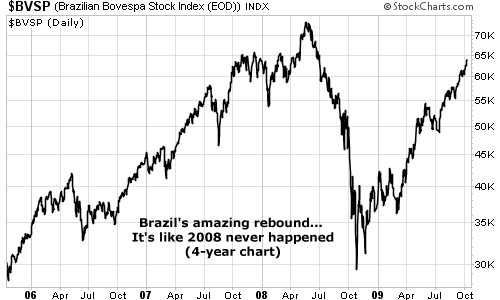| Home | About Us | Resources | Archive | Free Reports | Market Window |
Two Ways to Profit on a Huge New Currency TrendBy
Tuesday, October 13, 2009
The Reserve Bank of Australia hiked its interest rate this week...
This was a big piece of financial news. Central banks around the world have been cutting rates for two years, and interest rates are as low now as they've ever been. When a company raises its dividend, its stock becomes more attractive to investors. Its share price rises. When a bank raises interest rates on its savings accounts, people deposit more money in the bank. It's the same way in the currency markets. Rising interest rates make a currency more attractive and it rises against other currencies with stable interest rates... The governor of Australia's central bank hinted there would be more interest rate rises on the way. This could be the start of a new trend of rising interest rates around the world. Analysts say Canada, New Zealand, South Korea, and Norway are likely candidates to follow Australia's lead. If this is the start of a new trend of rising world interest rates, you can expect big new trends in the currency exchange markets, too. That's because interest rates are the single most important driver of exchange rates in the currency markets. Australia's currency has risen this week as investors celebrate the higher interest rates they'll receive for owning it. On the other hand, the dollar has fallen 15% in the last seven months. Newspapers will say it's because the Saudis want to price oil in euros or because the Fed prints too much money. This is garbage. The real reason is, it has the lowest interest rate of any major currency in the world except Japan, and speculators expect these low rates to remain indefinitely. So how do you make money from a new global trend of rising interest rates? While other central banks are considering raising rates, the Fed has so far refused to join the party. The dollar is the worst-performing major currency in the world this year as a result. Two weeks ago, the Bureau of Labor released its monthly unemployment report. The report showed that somewhere close to 6 million jobs have vanished from the American economy in the last 18 months. As I write, jobs are still disappearing, albeit at a slower pace. The employment situation hasn't been this bad since World War II ended and defense contractors eliminated 4.3 million jobs no longer needed for the war effort. With the ongoing unemployment bloodbath, rate hikes in America are unlikely until next year. First, this gives you a great opportunity to buy the dollar right now, while it's cheap and no one is anticipating rate hikes from the Fed. For regular investors, UUP is the best way of profiting if the dollar rises. It's a fund that replicates the performance of the dollar against a basket of the euro, Japanese yen, British pound, Canadian dollar, Swedish krona, and Swiss franc. By the time Bernanke announces his first rate hike next year, the dollar will have already rallied 10% or more. Second, a trend of rising interest rates on currencies is great for people looking to buy gold at lower prices. Gold has no interest rate. So when interest rates rise on world currencies, they become more attractive – and they rise – relative to gold. This is especially true with the dollar. It's the world's reserve currency and gold is incredibly sensitive to movements in its interest and exchange rates. As long as unemployment keeps rising, there's no way the Fed raises interest rates and gold prices will stay high. But next year is a different story. The first hint of rate increases by the Fed will send shockwaves into the gold market. If you're looking to buy gold, wait until Bernanke starts raising interest rates. By then the market will have already discounted the rate hikes and gold will be forming a low point. Good investing, Tom
Further Reading:
The Best Currencies for Diversifying Your Savings Market NotesA STUNNING REBOUND IN BRAZIL
It's like 2008 never even happened... at least for Brazil.
This year, the question for almost any country's stock market isn't "if" it is rising, but "how much." Brazil answers with, "So much that we're near an all-time high." As you can see from today's chart, Brazil's benchmark stock index has rebounded to pre-crash spring 2008 levels... and is close to its all-time peak reached last May. It's an amazing rebound few countries can claim. It's a rebound driven by a big rally in commodities this year. Brazil is home to Petrobras, one of the most successful major oil firms of the past decade (up 100% this year). It's home to Vale, the world's largest iron ore producer (up 113% this year). And Brazil has a unique agriculture "kicker." It has vast quantities of rich farmland and fresh water... which make it a major producer of coffee, livestock, orange juice, soybeans, and sugar. Brazil's "it's like 2008 never happened" rebound leads us to tag the country the "Ferrari of emerging markets." If commodity prices remain robust over the coming years, this market will double from current levels and double again. 
|
In The Daily Crux
Recent Articles
|

